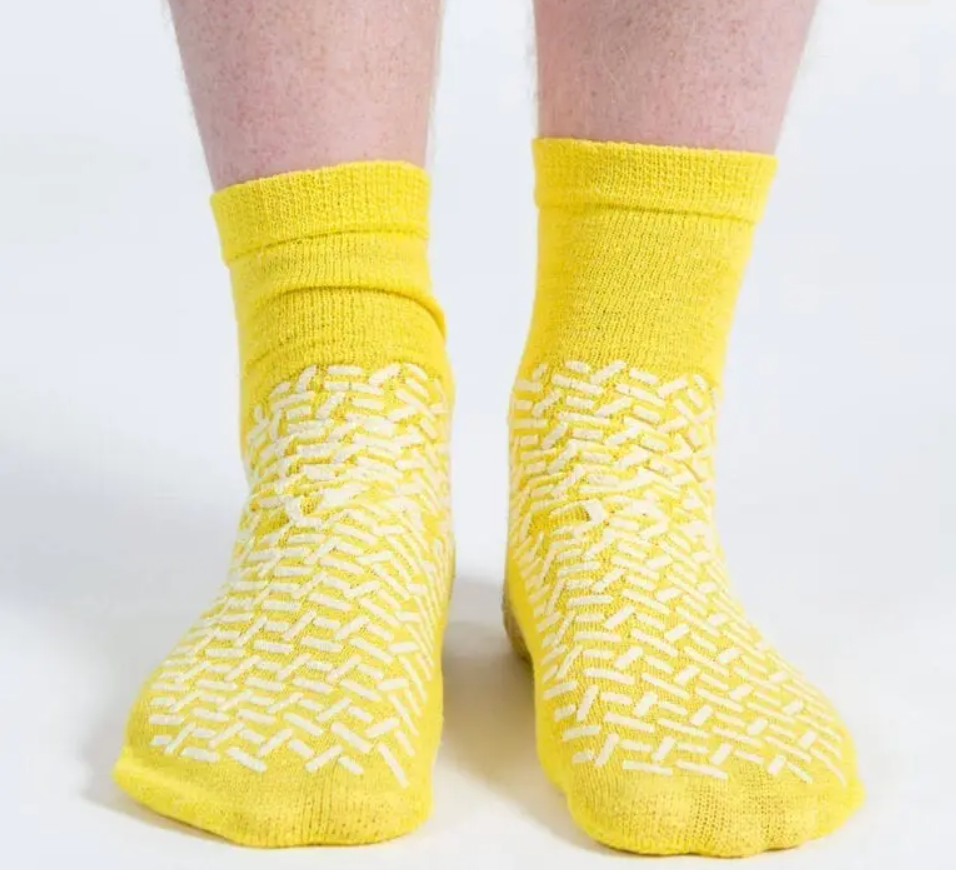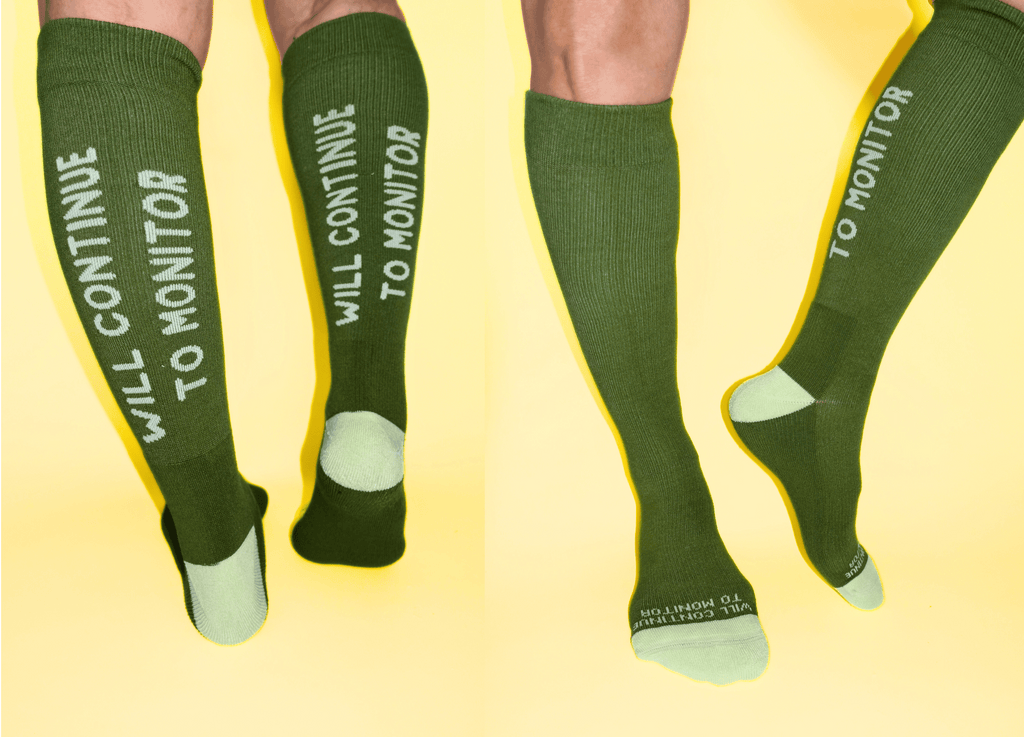What Do Different Hospital Sock Colors Actually Mean?

The top question we see when it comes to hospital socks is “what do different hospital sock colors mean?" It’s a logical question to ask considering color codes are embedded into hospital culture and guidelines. For example, different color hospital codes alert staff about an emergency, color specific scrubs sometimes indicate the department or role of a staff member, and colored wristbands represent a patient's medical condition.
Despite this, when it comes to different hospital sock colors, there is no consistency between hospitals. If you're asking yourself "what the heck are hospital socks," this intro blog on why people love hospital socks might help fill in the gaps :)
There is no universal code between hospitals. Every hospital is different. Different administrators, different rules, codes, policies, etc.
Hospital Sock Colors Can Mean Different Things Everywhere
What we talk about below might be different for your local hospital given every hospital is different with their unique policies and administrative guidelines. However, what we've realized is more often than not hospital sock colors don’t mean much or don’t mean what you’d hope they do. Sorry to burst your bubble! When it comes to what hospital sock colors mean, there are two scenarios we see the most in hospitals.
Hospital Sock Colors Represent Sizes
I work at a hospital and we have two hospital sock colors, blue and beige. The colors represent the size of the sock.
The first scenario we commonly hear is that different hospital sock colors correlate to different sizes, so hospital workers can quickly identify the right size for the patient to save time instead of digging through pairs. The size is also usually printed in big, obvious text where the grip is located. It helps with efficiency, so nurses can focus on other medical priorities. Hospital temperatures are often cold and patients frequently request socks and blankets to stay warm.




Yellow socks on the other hand have a more common meaning. They are meant to identify fall risk patients and are the only hospital sock color that usually has significance to hospital staff.
Hospital that I work at have a fall risk behind the bed on the board and a yellow blanket and yellow grippy socks so we know who's at risk of falling.
Bright Yellow Hospital Sock Colors Scream Fall Risk!
The second scenario we commonly hear from hospital workers is that the majority of hospital sock colors are the same with an additional yellow sock used to identify fall risk patients. Basically in this scenario, the hospital sock colors don’t really mean anything besides yellow.
So there you have it folks. The only statement that holds true is that a yellow hospital sock color equals fall risk patients. This is consistent feedback across different hospitals. Yellow is bright, represents “caution”, and catches people’s attention so nurses can identify these patients more easily. Some online forums have mentioned red socks being the fall risk identifier, but we would confidently say yellow is what the majority tend to follow.
The same holds true at a psych ward where the same grip socks are given out to patients. In psych wards, grip socks have taken on a life of it's own in recent years, representing a community of patients in the psych ward.

In our area hospitals they give yellow socks to ppl who have a risk of falling. Everyone else gets brown.
The above yellow sock has grips on top of the sock. This is also called double treaded or double sided grips. There are benefits and drawbacks to having grips on both sides. Besides yellow hospital socks, there is no universal standard for what the other hospital sock colors mean. Again, every department and hospital might be unique.
We’ve read in another article that red socks means patients should not get out of bed without help, green socks means the patient is independent, or purple socks mean the patient is Do Not Resuscitate (DNR). However what we do know is that in an emergency room setting, hospital sock colors are the last thing on a doctor or nurses’ mind when they are treating you.
The hospitals near where I live use hospital sock colors to show fall risk. Green means you can get up and move on your own. Yellow means you can move short distances on your own like from the bed to the chair and back again but need help from a nurse or family to use the bathroom. Red is do not get out of bed without a nurse there.
Grip socks logically make sense for fall risk patients, because their use is preventing falls. However, the most critical condition to be wary of is if the patient is DNR. Socks are not an ideal way to alert staff especially when the patient is coding real-time, because socks are really easy to take off and easy to hide under a blanket! It’s not the best way for the nurse to know a patient is DNR. And what happens when someone comes in wearing purple socks? Sounds like a recipe for disaster, which is why staff don’t rely on hospital sock colors. What staff do pay attention to however is if you have a colored wristband on, which is an identifier that has a lot more standardization in hospitals today than hospital sock colors.

If fall risk patients get stronger and are no longer fall risk, will nurses prioritize switching out their yellow sock for another hospital sock color? Highly unlikely! Like we said, creating a universal standard for hospital sock colors is on the bottom of the priority list for a lot of staff, but the important thing to remember is that despite the color, patients still enjoy receiving them and it keeps them warm! They're also great for moms in labor to keep their feet slip-free and clean.
What About Other Colors?
While yellow socks are commonly used in hospitals to indicate fall risk, the meaning behind other colors may be less clear. In fact, many hospital sock colors are meaningless to healthcare workers, and may not convey any specific information about a patient's health status or risk level. Several people are curious about the meaning behind blue hospital socks because blue is such a prominent color in the hospital with codes and scrubs.
It's important to remember that the use of different colors and their meanings can vary between hospitals, and there is no universal consistency in the use of hospital socks. This is why it's advisable to not trust online sources or general information about hospital sock colors. The best way to understand the meaning behind a specific color is to ask the nurse or doctor who works at the hospital you are going to.
Are Hospital Socks Just an American Thing?
Hospital socks are not necessarily an American phenomenon, as they are used in medical facilities all over the world. The use of specialized socks in hospitals is a common practice in many countries, and is seen as an important part of patient care and safety.
However, while hospital socks are widely used, the specific meanings behind different colors can vary between hospitals and even between regions. This lack of standardization is one reason why hospital socks are sometimes seen as an American phenomenon, as the use of different colors and their meanings may be more prevalent in the US than in other countries.
Germany here. No hospital socks and no yellow wrist band "Fall risk"
In any case, the use of specialized socks in hospitals is a global practice, and is seen as an important part of patient care and safety in many countries around the world.
Hospital sock colors can be a confusing topic for patients, as the meaning behind different colors can vary between hospitals and regions. While yellow socks are commonly used to indicate fall risk, the meanings behind other colors may not be as clear or consistent.
Despite the lack of standardization, hospital socks serve a vital role in patient care and safety. They are a source of comfort and warmth for patients, who may be spending long hours in hospital beds. Better quality grip socks also make a great gift for hospital patients to help them stay cozy and warm during their stay and post-stay during recovery.
So whether you're wearing yellow, blue, or any other color of hospital sock, remember that they serve an important purpose and contribute to your overall well-being while you're in the hospital. And if you're ever unsure about the meaning behind a specific color, don't hesitate to ask your nurse or doctor for clarification. They'll be happy to help!
While the meanings behind different colors might lack universal clarity, the comfort and warmth they bring to patients are undeniable. So, whether you're navigating the hospital corridors in yellow, blue, or any other color, these socks play a crucial role in your well-being during hospital stays. At Dr. Socko, we understand the importance of laughter and joy during tough times, especially in a hospital setting.
That's why we've reimagined hospital grip socks based on valuable feedback from patients like you. Our socks are not just a necessity; they're a source of smiles, even in the slipperiest situations. With features like a better fit, seamless design, and vibrant colors, Dr. Socko Hospital Grip Socks are here to elevate your hospital experience.
Curious about the variety of hospital sock colors we offer? Explore our collection now and add a touch of humor and style to your hospital wardrobe. Because when life gives you slippery situations, Dr. Socko gives you the grip—and a reason to smile!



